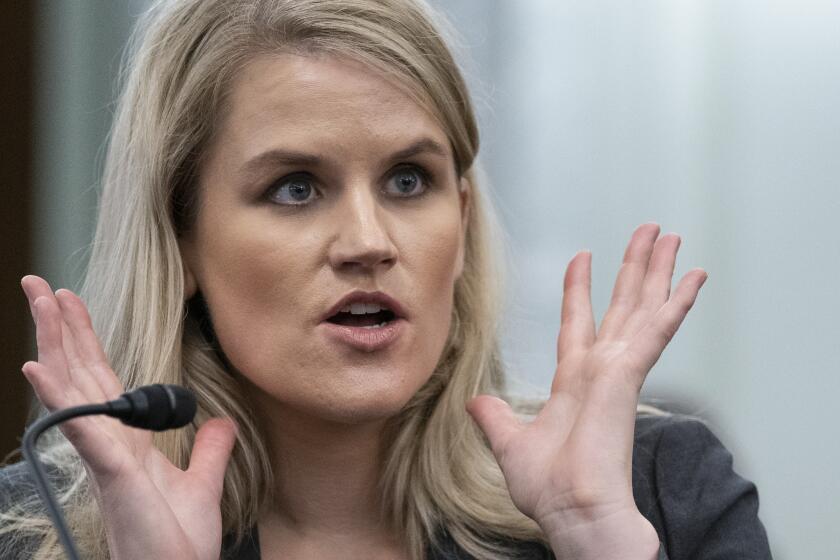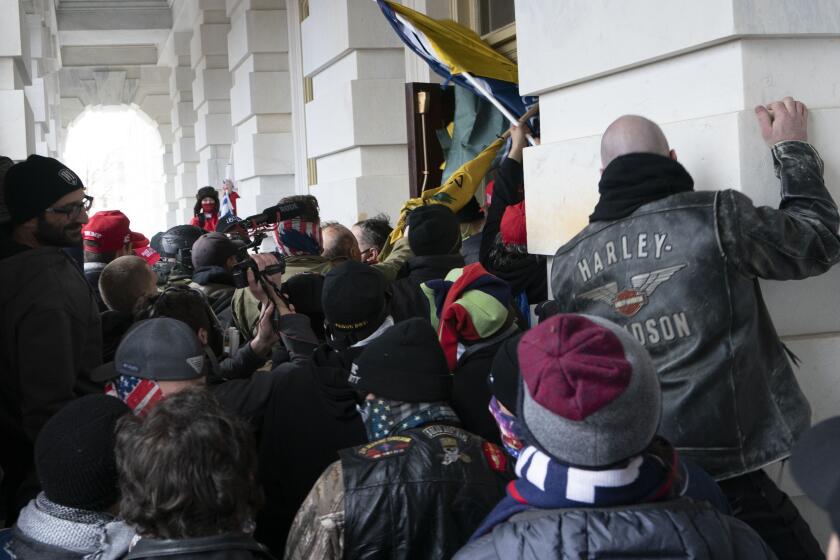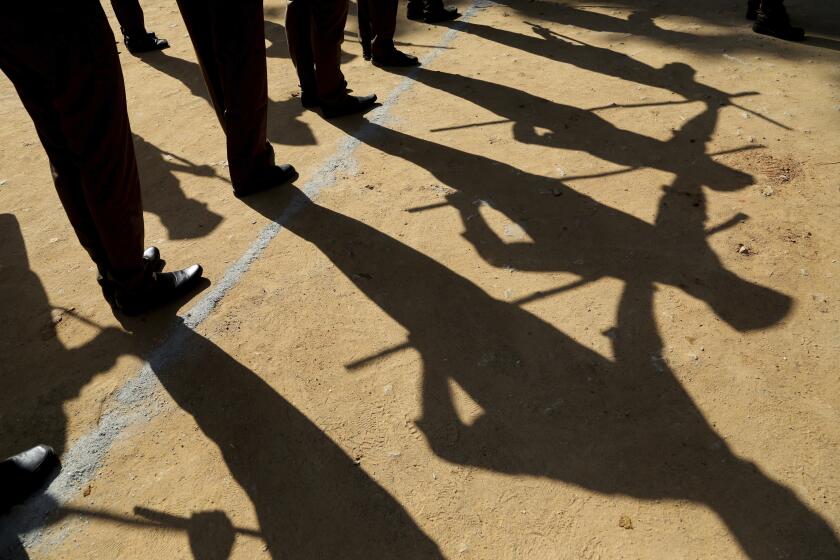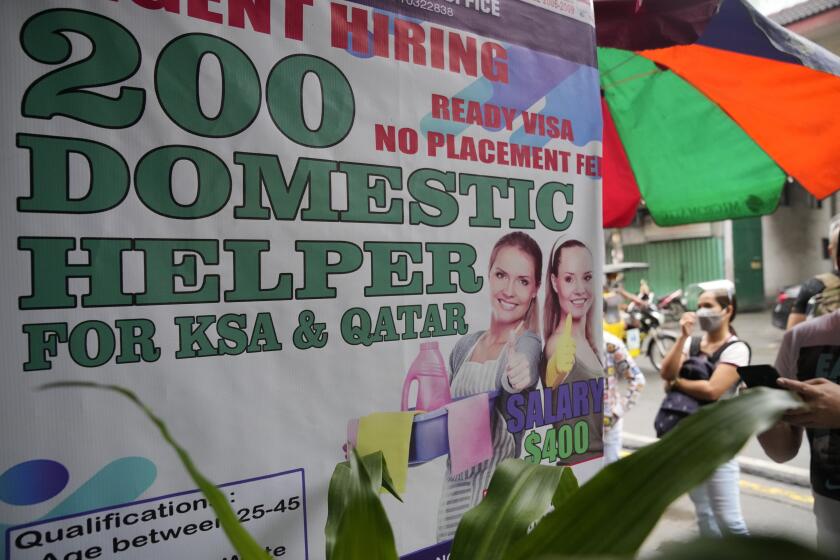America ‘on fire’: Facebook watched as Trump post ignited hate during Floyd protests

- Share via
COLUMBUS, Ohio — The reports of hateful and violent posts on Facebook started pouring in on the night of May 28 last year, soon after then-President Trump sent a warning on social media that looters in Minneapolis would be shot.
It had been three days since George Floyd, a Black Minneapolis resident, was murdered by a white police officer who knelt on his neck for nearly 10 minutes. Protests had erupted in Minnesota’s largest city and would soon spread to the rest of the U.S.
But it wasn’t until after Trump posted about Floyd’s death that reports of violence and hate speech increased “rapidly” on Facebook across the country, an internal company analysis of Trump’s post reveals.
“These THUGS are dishonoring the memory of George Floyd and I won’t let that happen,” Trump wrote at 9:53 a.m. on May 28, 2020, on his Twitter and Facebook accounts. “Any difficulty and we will assume control but, when the looting starts the shooting starts!”
The former president has since been suspended from both Twitter and Facebook.
Leaked Facebook documents provide a first-hand look at how Trump’s social media posts ignited more anger in a deeply divided country that was eventually set “on fire” with reports of hate speech and violence across the platform. Facebook’s own internal automated controls, meant to catch posts that violate rules, predicted with almost 90% certainty that Trump’s message broke the company’s rules against inciting violence.
Former Facebook manager Frances Haugen tells British lawmakers that the company’s algorithms help push people toward extreme views.
But the tech giant didn’t take any action on Trump’s message.
Offline, on the next day, protests — some of which turned violent — engulfed nearly every U.S. city, big and small.
“When people look back at the role Facebook played, they won’t say Facebook caused it, but Facebook was certainly the megaphone,” said Lainer Holt, a communications professor at Ohio State University. “I don’t think there’s any way they can get out of saying that they exacerbated the situation.”
Social media rival Twitter, meanwhile, responded quickly at the time by covering Trump’s tweet with a warning and prohibiting users from sharing it any further.
New internal documents provide a rare glimpse into how Facebook appears to have simply stumbled into the Jan. 6 riot.
Facebook’s internal discussions were revealed in disclosures made to the Securities and Exchange Commission and provided to Congress in redacted form by former Facebook employee turned whistleblower Frances Haugen’s legal counsel. The redacted versions received by Congress were obtained by a consortium of news organizations, including the Associated Press. The Los Angeles Times is not a member of the consortium.
The Wall Street Journal previously reported that Trump was one of many high-profile users, including politicians and celebrities, exempted from some or all of the company’s normal enforcement policies.
Hate speech and violence reports had been mostly limited to the Minneapolis region after Floyd’s death, the documents reveal.
“However, after Trump’s post on May 28, situations really escalated across the country,” according to the memo, published June 5, 2020.
Despite having found ways to reduce COVID-19 vaccine misinformation on its platform, Facebook delayed acting on suggestions from its own researchers.
The internal analysis shows a fivefold increase in violence reports on Facebook, while complaints of hate speech tripled in the days following Trump’s post. Reports of false news on the platform doubled. Re-shares of Trump’s message generated a “substantial amount of hateful and violent comments,” many of which Facebook worked to remove. Some of those comments included calls to “start shooting these thugs” and “f— the white.”
By June 2, “we can see clearly that the entire country was basically ‘on fire,’” a Facebook employee wrote of the increase in hate speech and violence reports in the June 5 memo.
Facebook says it’s impossible to separate how many of the hate speech reports were driven by Trump’s post itself or the controversy over Floyd’s death.
“This spike in user reports resulted from a critical moment in history for the racial justice movement — not from a single Donald Trump post about it,” a Facebook spokesperson said in a statement. “Facebook often reflects what’s happening in society and the only way to prevent spikes in user reports during these moments is to not allow them to be discussed on our platform at all, which is something we would never do.”
Internal Facebook documents acknowledge that the company often does a poor job of monitoring content because of its own linguistic shortcomings.
But the internal findings also raise questions about public statements that Facebook Chief Executive Mark Zuckerberg made last year as he defended his decision to leave Trump’s post untouched.
On May 29, for example, Zuckerberg said the company looked closely to see if Trump’s words broke any of its policies and concluded that they did not. Zuckerberg also said he left the post up because it warned people of Trump’s plan to deploy troops.
“I know many people are upset that we’ve left the President’s posts up, but our position is that we should enable as much expression as possible unless it will cause imminent risk of specific harms or dangers spelled out in clear policies,” Zuckerberg wrote on his Facebook account the night of May 29 as protests erupted around the country.
Yet Facebook’s own automated enforcement controls determined that the post likely did break the rules.
Breaking News
Get breaking news, investigations, analysis and more signature journalism from the Los Angeles Times in your inbox.
You may occasionally receive promotional content from the Los Angeles Times.
“Our violence and incitement classifier was almost 90% certain that this [Trump] post violated Facebook’s ... policy,” the June 5 analysis reads.
That also contradicts conversations Zuckerberg had with civil rights leaders last year trying to quell concerns that Trump’s post was a specific threat to Black people protesting Floyd’s death, said Rashad Robinson, the president of Color of Change, a civil rights advocacy group. The group spearheaded a boycott of Facebook in the weeks following Trump’s post.
“To be clear, I had a direct argument with Zuckerberg days after that post where he gaslit me and he specifically pushed back on any notion that this violated their rules,” Robinson said in an interview with the AP last week.
A Facebook spokesperson said that its internal controls do not always correctly predict when a post has violated rules and that human review, which was done in the case of Trump’s post, is more accurate.
Apple threatened to pull Facebook from its app store in 2019 over concerns that the platform was being used to trade and sell maids in the Mideast.
To curb Trump’s ability to stoke hateful reactions on its platform, Facebook employees suggested last year that the company limit re-shares on similar posts that might violate Facebook’s rules in the future.
But Trump continued to use his Facebook account, which more than 32 million follow, to fire up his supporters throughout much of the remainder of his presidency. In the days leading up to the insurrection at the U.S. Capitol on Jan. 6, Trump regularly promoted false claims that widespread voter fraud caused him to lose the election.
It wasn’t until after the riot, and as Trump was on his way out of the White House, that Facebook pulled him off the platform in January, announcing that his account would be suspended until at least 2023.
There’s a reason Facebook waited so long to take any action, said Jennifer Mercieca, a professor at Texas A&M University who closely studied Trump’s rhetoric.
“Facebook really benefited from Trump and Trump’s ability to draw attention and engagement through outrage,” Mercieca said. “They wanted Trump to keep going on.”
More to Read
Sign up for Essential California
The most important California stories and recommendations in your inbox every morning.
You may occasionally receive promotional content from the Los Angeles Times.













